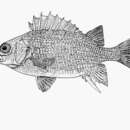Diagnostic Description
provided by Fishbase
Body deep and somewhat compressed; caudal peduncle narrow; eyes large; pelvic fins with 1 spine and 7 soft rays (I, 7); preopercle with small serrations and a large, pointed spine at the angle; body violet pink; back bronze (Ref. 55763). Branchiostegal rays: 8-8 (Ref. 36626).
Life Cycle
provided by Fishbase
Oviparous (Ref. 36626). Also Ref. 240.
Morphology
provided by Fishbase
Dorsal spines (total): 11; Dorsal soft rays (total): 13 - 14; Analspines: 4; Analsoft rays: 8 - 9; Vertebrae: 27
Trophic Strategy
provided by Fishbase
Adults hide in small caves or in crevices and cracks of rocks during the day. At night, they feed on small crustaceans in the intertidal zone, less than 3 m in depth. Planktivore (Ref. 57615).
Biology
provided by Fishbase
Adults hide in small caves or in crevices and cracks of rocks during the day. At night, they feed on small crustaceans in the intertidal zone, less than 3 m in depth. Oviparous, with planktonic larvae (Ref. 36626). Appear only occasionally in markets where it is sold fresh.
- Recorder
- Cristina V. Garilao

